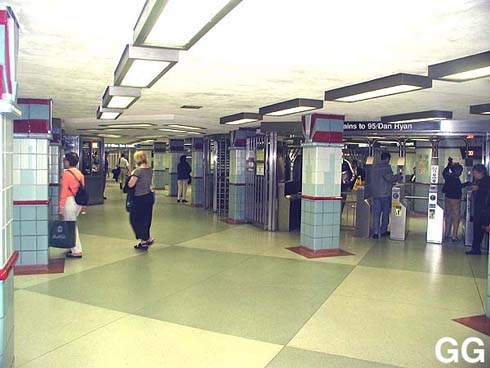
The remodeled, Art
Deco-influenced mezzanine at Randolph-Washington, looking
west from the doorway to the Pedway and Marshall Fields on
June 8, 2001. The turnstiles on the right (under the sign
reading 'Trains to
95/Dan Ryan') lead down
to the Lake
station, while the turnstiles on the left (obstructed by the
columns) lead to the Washington station. For a larger view,
click here.
(Photo by Graham
Garfield)
|
|
Washington
|
|
(128N/1E-1W)
Randolph-Washington
|
|
|
|
(20N/1E-1W)
Washington-Madison
|
Washington Street and State Street,
Loop
Service
Notes:

|
Red Line: State
Street Subway
|
Quick Facts:
|
Address:
|
128 N. State Street
(Randolph-Washington
mezzanine)
|
|
20 N. State Street
(Washington-Madison
mezzanine)
|
Established: October 17, 1943
Original Line: State Street Subway
Previous Names: none
|
Skip-Stop Type:
|

|
Station
|
Rebuilt: 1982, 1996
Status: Closed
History:
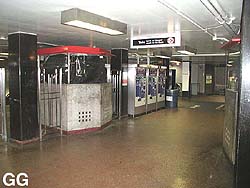
The Washington-Madison
mezzanine, looking southwest on June 8, 2001. Except for the
modern AVMs, the mezzanine is still largely untouched from
when it opened in 1943. The booth on the left is, however,
disused now and passengers cannot access the platform from
the south stairs. For a larger view, click here.
(Photo by Graham
Garfield)
|
Washington was typical of all the State Street subway stations.
Described at the time as of a "modern design" (really somewhere
between art deco and art moderne), the mezzanine stations have smooth
concrete floors and ceilings and white glazed tile walls (sometimes
referred to as "structural glass"). The fare control booth is of
stone walls with a small ventilation grate near the bottom and glass
windows on all four sides. Turnstiles were steel. The Washington
station actually consisted of three mezzanines -- from north to
south: Lake-Randolph, Randolph-Washington, and Washington-Madison --
with a staggered stopping pattern between the three. The island
platform, 3,500 feet long, in the Guinness Book of World Records as
the longest subway platform in the world, has red no-slip concrete
floors, curved concrete ceilings and I-beam steel columns.
Fluorescent lights and illuminated station signs hanging from the
ceilings originally finished the decoration.
Unfortunately, neither the State Street nor Milwaukee-Dearborn
subways have direct connections to the Loop elevated stations. Free
transfers were provided, however, between Washington/State and
State/Lake on the Loop. (Transfers were
also initially allowed between Jackson/State
and State/Van Buren, but apparently
discontinued when CTA took
over in 1947.) In 1958, with the opening of the new Congress Line and
the inauguration of West-Northwester service, "L"-to-subway transfers
were revised. Free transfers between Randolph/Wells
and Lake Transfer and between
State/Lake and Washington/State were
discontinued. The "up" (subway-to-"L") transfer between Lake
Transfer and Clark/Lake was
maintained, but a new "down" only between State/Van Buren and
Jackson-Van Buren/Dearborn was initiated, as well as an "up" and
"down" transfer between State/Van Buren and Jackson-Van
Buren/State. The free transfers between State/Van Buren,
Jackson-Van Buren/Dearborn and Jackson-Van
Buren/State were discontinued in 1969 when the Dan Ryan Line
opened and West-South service was inaugurated. At this time, free
transfers between State/Lake and
Washington/State were reinstated. Because there is no physical
connection between the paid areas of these stations, riders had to
exit the subway station after having their transfer stamped by a
machine and enter the elevated station, presenting their stamped
transfer to the agent. In December 1971, the transfer-issuing booth
at Washington was moved from the platform to the Lake-Randolph
mezzanine, which was the closest to the State/Lake
elevated station.
Amid a series of station closures and service reductions in the
1970s, the Washington-Madison mezzanine entrance to the station was
closed from 2200 to 0600 hours Monday-Saturday and all day Sundays
effective September 12, 1976.
Washington Gets a
Facelift
Mayor Byrne announced the Subway Renovation Program on Friday, May
7, 1982, beginning a program that also included her inaugural ride on
CTA's new 2600-series
rapid transit cars, and a rededication of the 47th
Street station.
The Subway Renovation Program, encompassing both the State and
Dearborn Street Subways, included the continuous platforms on State
between Lake and Congress and on Dearborn between Randolph and Van
Buren; the 14 mezzanines along these platforms (Lake-Randolph,
Randolph-Washington, Washington-Madison,
Madison-Monroe, Monroe-Adams,
Adams-Jackson, Jackson-Van
Buren, and Van Buren-Congress on
State and Randolph-Washington
through Jackson-Van Buren on Dearborn); and the four pedestrian
passageways connecting the State and Dearborn Subways here and at
Jackson at both the mezzanines and platforms. In addition, mezzanines
and platforms would have been renovated at Chicago,
Grand, Harrison, and Roosevelt
on State and the Lake Transfer and
LaSalle/Congress stations on
Dearborn.
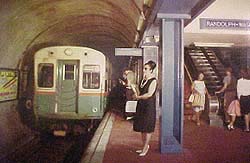
Above: The continuous
platform at Washington station, looking north at the stairs
to the Randolph-Washington mezzanine in 1965 as a Jackson
Park "B" train of 6000s
approaches. (Photo from the Graham
Garfield Collection)
Below: Nearly the
same view, looking north toward the stairs to
Randolph-Washington on June 8, 2001. The stair enclosure has
been remodeled in an Art Deco-influenced style, but the
platform remains largely the same. For a larger view, click
here.
(Photo by Graham
Garfield)
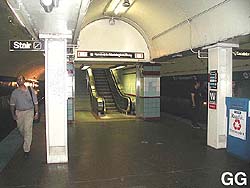
|
At all mezzanines, the existing facilities were to be stripped back
to their basic structural shell and completely renovated with gray
granite panels with stainless steel accents. New fare collection
facilities, lighting, flooring, and column coverings were also to be
installed. A uniform system of signage and maps would be provided and
facilities for the enhancement of passenger security would be
incorporated. Amenities such as telephones and concession areas would
also have been provided as appropriate. At the platform level, new
lighting, flooring, wall, ceiling, and column treatments would have
been provided. Stairways and escalators from the platforms to the
mezzanines would be replaced or renovated in kind. Signage, maps,
benches, and concession facilities will be compatible with those
developed for the mezzanine.
The Randolph-Washington mezzanine closed on May 7th and renovation
began Tuesday, May 25, 1982 and simultaneously at the Randolph-Washington
mezzanine on the Milwaukee-Dearborn Subway. At the same time, the
Washington-Madison mezzanine temporarily returned to 24 hour service
for the duration of the renovation work. Work was completed swiftly,
with the Randolph-Washington mezzanines on both the State and
Dearborn Subways reopening on November 26, 1982. On the same date,
the Washington-Madison mezzanine returned to part-time hours.
Work at the other stations proceeded at a delayed rate or, in some
cases, not at all. None of the other State Street mezzanines were
remodeled at this time, with the Washington-Madison
mezzanine in the Dearborn Subway the only other station remodeled
during Byrne's administration. The only other stations remodeled
under this program were Adams-Jackson mezzanines at Jackson/State
and Jackson/Dearborn in the early
years of the Richard M. Daley administration, some eight years later.
None of the platform-level remodeling was ever completed under this
program.
In 1993, the CTA installed
special turnstiles at State/Lake and at
the Lake-Randolph mezzanine at Washington that dispensed transfers.
Passengers transferring between the stations received a transfer upon
leaving through the special turnstile and presented it to the station
agent at the other station. In 1997, a new machine was installed in
the paid area at State/Lake that issued free "L"-to-subway transfers,
removing from service the special transfer-issuing turnstiles. On
June 22, 1997, electronic transit card vending machines were
activated at all Loop stations. Later that summer, the transit card
AVMs were activated at all Red Line stations and shortly thereafter,
transfers were granted between the Loop and the Red Line subway by
using transit cards only, which did not deduct the 30 cent transfer
when used.
The Renovation Gets Renovated
(Again)
The Randolph-Washington mezzanine became the only mezzanine to be
renovated twice, this time in the colorful Art Deco-influenced
style pioneered at Roosevelt/State
in the mid-1990s. On June 2, 1996, Randolph-Washington was closed at
0600 hours for renovation. The project included the installation of
new elevators, new flooring, new CA booths, new janitor, electrical,
and auxiliary control rooms, and new colored tile wall finishes in an
Art Deco motif, with the tones (in this case, red) denoting the line
and pictures on the tiles (in this case, silhouettes of skyscrapers)
denoting the station's location (downtown, here). The station's name
is also molded into the tile work and lighting has been improved
markedly. The lighter colors and airier design give the station a
more spacious feel, from the tile mosaic walls to the sunburst deco
column capitals. The stair/escalator bank was redecorated as well, as
was the elevator bank. The Washington section of the continuous
platform was not, however, part of the initial project.
The Washington-Madison entrance, formally a part-time mezzanine,
became open 24 hours for the duration of the project. At this time,
the Washington station began an interesting history of expanding and
contracting in length. With the closure of the Randolph-Washington mezzanine (which had
hereunto served as the middle of three mezzanines of the four-block
long Washington station) on June 2, 1996, two separate station stops were established for customer convenience, since the two remaining entrances at either end of the two-block-long former Washington station were so far away from each other. The north half of the former Washington stop, served by the Lake-Randolph mezzanine, was referred to as "Washington-Lake", and was intended to serve Loop "L"-subway transfers. The south half of the former Washington stop, served by the Washington-Madison mezzanine, was referred to as "Washington-Madison", and was intended to serve transfers to/from the Blue Line. (Some leftover signage at the south end of the platform
calling the stop "Madison" remained for some time.) On July 21, the continuous platform was divided into two parts due to construction around the Randolph-Washington mezzanine, physically separating the two Washington stops.
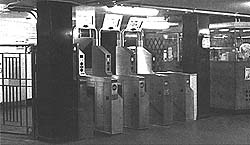
New Cubic Automatic Revenue
Collection fare gates have been installed at the
Washington-Madison mezzanine on July 2, 1996. The temporary
signs above the gates alert passengers that coins, tokens
and transfer cars are accepted; eventually, they'd be
converted to TransitCards. For a larger view, click
here.
(Photo by Art
Peterson)
|
On November 22, 1996, the north agent's booths in the
Randolph-Washington mezzanine were reopened at 1000 hours, serving
the Washington-Lake stop on a 24 hours a day/7 days a week basis.
This reopening was short-lived, however, as it was re-closed at 1930
hours on February 7, 1997 to allow further work to progress. Three
days later, however, the south portion of Randolph-Washington
reopened temporarily at 0600 hours as a part-time entrance between
0600 and 1930 hours, with renovation work continuing during the
off-hours.
On September 15, 1997, with most of the renovation work completed,
the dual stops at Washington were eliminated and the station became
unified again. In a reversal of the previous pattern, southbound
trains (to 95/Dan Ryan) stopped between
Lake-Randolph and Randolph-Washington and northbound trains (to
Howard) stopped between Randolph-Washington
and Washington-Madison. But soon, the wisdom of having two stops was
realized and this stopping pattern was re-instituted effective
November 18, 1997 at 1000 hours. The north end is again considered a
separate station, alternately referred to as "Lake-Washington" and
"Lake", but finally simply as Lake. Both
northbound and southbound trains now stop between each set of
mezzanines, with Randolph-Washington being in the unique position of
actually feeding two different stations: Washington to the
south and Lake to the north. The
Randolph-Washington mezzanine, however, still bears the signage
directing people to different ends for north- and southbound
trains.
The free transfer to the elevated at State/Lake
is now provided at the new Lake station from
Lake-Randolph, with Washington only providing a free transfer to the
Washington/Dearborn subway
station through a mezzanine walkway and a platform-level
tunnel, as it always did.
For additional information
and photos of the Lake station and Lake-Randolph mezzanine, click
here.
Later Developments
At a press conference on Monday, June 5, 2000,
CTA President Frank Kruesi
announced that beginning Saturday, June 10th and Sunday, June 11th,
six downtown area 'L' and subway stations and seven station entrances
that were currently closed late at night or on weekends would be open
at all hours that trains are in service. One of the seven secondary
station entrances was was a Part-Time Entrance -- closed nights and
weekends -- was the Washington-Madison entrance to Washington
station. Starting at 0600 hours Saturday, June 10th,
Washington-Madison entrance returned to 24-hour operation. Opening
these stations and entrances is just one of the components of a
$539,000 service improvement package that was passed by the Chicago
Transit Board in May 2000.
The glass panels in the illuminated signs over their
stair/escalator bank to the Washington-Madison mezzanine were still
the originals as of December 2001, and while this is might have been
great for aesthetics and historic preservation, it did create
somewhat of a logistical problem: because the sign plates were glass,
they were easily shattered by vandals. So, the
CTA desired to replace these
glass panels with Plexiglas or plastic ones that would not be as
easily broken and that would not pose a safety hazard if they were.
But, in their infinite wisdom and creativity, the signage designers
decided to mimic the lettering and style of the original signs as
much as possible. They found a font that was almost exactly
the same as the original typeface, and created street exit signs for
the stair/escalator banks to the Washington-Madison mezzanine, as
well as for Madison-Monroe and
Monroe-Adams (which also had their
originals), using the original layouts and wordings. (The original
"Escalator" signs remained, as they are high enough that it is
unlikely they will be broken.) The only concession they made was to
make the background black, rather than blue, red, green, or brown
like the originals, to match the current signage scheme. These were
installed in early January 2002.
As mentioned previously, neither the Lake-Randolph nor
Washington-Madison mezzanines were included in the 1996 renovation
program (with the former no longer even part of Washington station),
nor was the Washington section of the continuous platform. The
platform was scheduled to be remodeled, however, with an April, 1999
completion date and a price tag of $15 million. This did not come to
pass on-schedule, but it still planned by the Chicago Department of
Transportation (who actually owns the subways and leases their
operation to the CTA ).
According to the City's 2002-05 capital budget, a station platform
renovation between Randolph and Madison is planned to be initiated in
November 2001, with a completion date exactly two years later at as
cost of $21 million. A revised version of the City's budget plan
still has completion scheduled for November 2003, but extending all
the way north to Lake at a cost of $29,200,000. Plans have been drawn
up by CDOT, and include new flooring, dramatically revamped lighting
and signage schemes, new platform furniture and fixtures, and new
outer wall coverings. This work was planned to begin in 2004, but
then the CTA announced its plan for a new station under the adjacent
Block 37 property and a new subway tunnel connecting the Red and Blue
lines. This new subway tunnel would connect to the State Street
Subway right in the middle of Washington station's platform,
effectively cutting the continuous platform in two and requiring the
station to be re-sited. As such, CDOT reprogrammed the money and
renovation project one stop north to Lake,
where renovation work began in Summer 2004.
On June 6, 2005, the CTA launched a pilot program at eight rail stations (as well as on 10 of
its wide-door Nova buses) to help speed boarding for customers by
dedicating one turnstile as an express fare payment lane (called a
"Go Lane") for those paying with either Chicago Card (regular or
Plus) smartcard fare media. The dedicated lanes are identified by
signs over the turnstile and on the floor in front of it. The eight
selected rail stations in addition to the Randolph-Washington
mezzanine of Washington/State were Howard,
Chicago, 79th
and 95th/Dan Ryan on the Red Line; Jefferson
Park on the Blue Line; and both the Thompson Center and 203 N.
LaSalle entrances to Clark/Lake, and
the Randolph-Washington mezzanine of Washington/Dearborn
downtown. CTA chose these
stations because they are geographically balanced and serve a high
volume of customers who transfer between bus and rail.
The pilot was conducted to determine if providing a dedicated
turnstile at stations would help to speed boarding and, therefore,
speed service. The pilot also provided an additional incentive for
customers to switch to Chicago Card fare options. The faster and
easier the boarding process, the more the transit experience is
improved for existing customers. Faster boarding also helps to
attract new customers.
CTA monitored the Go Lane
boarding times during morning and evening rush periods to measure
time saved during boarding, as well as the ratio of customers using
electronic fare media compared to cash or transit cards. Customer
reaction and ease of use were also evaluated as part of the pilot to
determine whether use of Go Lanes should expand.
Changes, Closure for Block 37 Construction
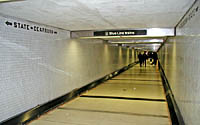
The upper-level transfer tunnel -- now part of the downtown Pedway system -- dates to the opening of the State Street Subway in 1943. The wall tile in this November 14, 2005 view is original, but the flooring and stainless steel light trays are from a later remodeling. The tunnel closed temporarily two days after this photo for reconstruction as part of Block 37. For a larger view, click here. (Photo by Graham Garfield) |
On Wednesday, November 16, 2005, the upper-level transfer tunnel between the Randolph-Washington mezzanines on the State Street Subway (Red Line) and Milwaukee-Dearborn Subway (Blue Line) closed for the construction of the Block 37 development on the land above it. The tunnel, which was a short but heavily-used section of downtown Chicago's underground pedestrian tunnel (aka 'the Pedway'), needed to be closed because excavation for the Block 37 development's foundation and lower levels required its demolition.
The Block 37 development was planned to feature a mix of uses including shops, restaurants, offices, a hotel and a residential tower. In addition, the project was to include a new subway tunnel running diagonally across the site on a northwest-southeast angle, connecting the Red and Blue line subways, and a basement-level station that was planned to ultimately serve a CTA airport express train service to O'Hare and Midway airports. When the Block 37 development was completed, the Pedway tunnel was to be integrated into the lower level of the building. The old straight, narrow, low-ceiling tunnel would be replaced by a wider, more open walkway with retail stores and an entrance to the Block 37 CTA station. However, in 2008, the CTA Airport Express "superstation" was mothballed due to cost overruns, lack of capital funds to make the other infrastructure improvements needed to make an airport express service feasible, and limited interest from private operators to run the express service, as was desired by the CTA.
The construction of the Block 37 development, and specifically the subway tunnel beneath it, affected Washington station again when, in Fall 2006, construction had progressed to the point where preparations had to be made to make the connections to the existing subway tunnel. The Block 37 tunnel construction required the temporary closure of Washington/State station. At midnight on
Monday, October 23, 2006, CTA discontinued making station stops at the Washington portion of the
continuous platform, leaving only the Lake, Monroe, and Jackson stops. The Washington-Madison mezzanine closed and the portion of the continuous platform between Randolph-Washington and Washington-Madison was barricaded. The Randolph-Washington mezzanine remained open, however, continuing to feed the south end of the Lake station. The lower-level transfer tunnel connecting the Washington Red and Blue line subway stations was also closed effective the same date, leaving the transfer tunnel at Jackson for free connection between the Red and Blue lines.
The new Pedway under Block 37 opened after rush hour on Friday evening, November 20, 2009. At the time, the developer was still putting finishing touches on the mall and none of the Pedway-level stores were open. However, some of the stores opened shortly after, along with the connection to the street-level arcade of stores. The new Pedway, rather than being its own tunnel, was fully integrated into the lower level of the Block 37 mall, with the middle of the Pedway being an atrium open to the floors above and allowing natural light into the walkway.
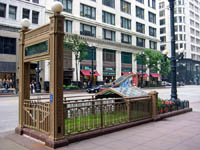
The northwest stairway to the closed Washington-Madison mezzanine is seen on June 15, 2010 after being converted into a planter to beautify the unused entrance. A decorated escalator kiosk is visible in the background. For a larger view, click here. (Photo by Graham Garfield) |
While the Block 37 station was under construction, the continuous platform in the middle of the former Washington station stop was excavated, with a trench cut through the platform between the transfer tunnel stairs for a future track connection from the southbound subway track (Track A) into the Block 37 station. The ceiling vault over the platform was also removed and the transfer tunnel stairs reconfigured to move the south stair further south on the platform (closer to the Washington-Madison mezzanine) so that it would clear the future turnout into the Block 37 station. The transfer tunnel stairs were also widened to nearly fill the width between the rows of columns along edges of the platforms.
After the Block 37 'superstation' was mothballed, work at the Washington station was halted. In late 2009 and early 2010, work was performed to restore the gap in the continuous platform and improve the platform area sufficiently so that passengers could traverse it should it be necessary, such as during a train evacuation. It was not, however, restored sufficiently for trains to resume stopping there, nor was the Washington-Madison mezzanine improved to allow it to reopen for revenue service. The missing section of platform was rebuilt and a plain concrete floor laid. The ceiling was put back and painted white, and lighting installed. The new stairways to the lower transfer tunnel were surrounded in plywood enclosures to prevent passenger access. At 10:45am, Wednesday, February 10, 2010, the continuous platform at Washington, between the Madison-Monroe and Randolph-Washington mezzanines, was reopened, with the plywood barricades that had blocked access since 2006 removed. Trains continued bypassing the former station stop and the Washington-Madison mezzanine and the lower-level transfer tunnel to the Blue Line remained closed.
During late spring 2010, the street-level entrances on State Street to the Washington-Madison mezzanine were decorated and covered to improve their appearance. Litter was blowing down the stairs and piling up at the blocked entrance kiosks, so the CTA worked with the Chicago Loop Alliance on a beautification plan to improve the entrances' appearance. The escalator enclosures were covered with graphics to hide the view of the disused escalators within. The stairways were covered with planters, essentially making the stair enclosure a planter enclosure.
The CTA does not consider the Washington/State station officially permanently closed, but the agency says there are currently no plans to reopen it1.

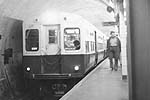
|
washington-state01.jpg
(39k)
A 6000 stops at
Washington/State in 1974.
(Photo by Leon Kay)
|

|
cta2241c.jpg
(113k)
On a fantrip, 2241 leads a chartered train (note the
"Not in Service"
roll sign and the white-white marker reading) at
Washington/State on July 4, 1971. Note the sign on the
tunnel wall indicating the location of the train stop;
berthing locations used to be a bit more staggered down the
platform than they are today. (Photo by Joe
Testagrose)
|
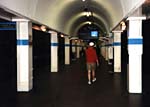
|
washington-state04.jpg
(125k)
Until the 1990s, the Washington platform has stopping berths
staggered for the different directions of travel. The berth
for southbound Jackson Park-Englewood trains, seen here
looking north in July 1992, was between the
Randolph-Washington and Washington-Madison mezzanines. The
CTA Information monitor overhead was a shirt-lived amenity
that provided info such as the time, date, weather, and
travel updates, but they proved to be maintenance-prone.
Note the blue stripes on the columns: they do not represent
the Blue Line, as such stripes would in the late-1990s and
early-2000s, but rather Washington's signature accent color,
a feature dating back to the original design of the 1940s
subway stations.
(Photo by Tony Nowikowski)
|
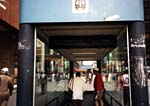
|
washington-state05.jpg
(155k)
As part of the Skidmore Owings & Merrill-designed State
Street pedestrian mall, built in 1979, the subway entrances
all received simple, modern kiosk enclosures, with rounded
black corners, glass walls, and colored caps with the
CTA's simple rapid
transit train icon. This Washington entrance, already well
weathered by this July 1992 view, indicates access not only
to the North-South Route of the State Street Subway but also
to the Dearborn Subway by way of the transfer
tunnel. (Photo by
Tony Nowikowski)
|

|
washington-stateEntry.jpg
(86k)
In 1996, the renovation of State Street was complete,
dismantling the pedestrian mall that had been created in
1979. The street was reopened to traffic and the streetscape
was remodeled with reproductions of the original
streetlights and other hardware designed to match the early
period. This included attractive new subway entrances like
these along the street. Of course, the State Street Subway
never actually had old-fashioned entrances like these, being
that it wasn't built until the 1940s. (Photo
from the Proposed 1999 CTA Annual Budget)
|
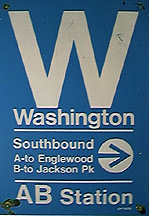
|
washington-stateSign.jpg
(25k)
Washington station sign, from before the Howard was
repaired with the Dan Ryan Line. (Sign from
the collection of Graham Garfield)
|
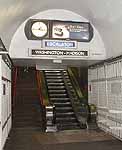
|
washington-madison03.jpg
(65k)
A new backlit sign for the Washington-Madison mezzanine uses
old-style Futura-like lettering to harken back to the
original 1940s subway graphics. However, its presence below
an original sign plate belays the differences between the
new facsimile and the real article. (Photo
by Graham Garfield)
|
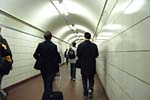
|
washington-TransferTunnel.jpg
(90k)
The State and Dearborn subways, begun at the same time and
only a block apart downtown, were designed to have free
transfers between them at two stations via low-level
tunnels. Here, passengers are using the transfer tunnel at
Washington to go from one subway to the other. It is not
uncommon to see customers with suitcases (as the Blue Line
services O'Hare Airport), especially at Washington (the
first of the two transfer stations after
O'Hare). (Photo by Paul McAleer)
|
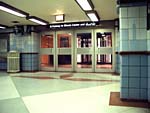
|
randolph-washington02.jpg
(146k)
On the east side of the Randolph-Washington mezzanine is the
entrance is Marshall Field's and the Pedway. Originally,
this was a direct entrance to Field's only, similar to other
department stores' direct entrances from the subway. Later,
the Pedway was extended through here and connected in east
of Field's, which already had basement-level corridors. The
entrance is seen here on December 18, 2003.
(Photo by Graham Garfield)
|
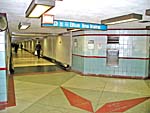
|
randolph-washington03.jpg
(169k)
On the west side of the Randolph-Washington mezzanine is the
entrance to the upper-level transfer tunnel between the
Randolph-Washington mezzanines on the Red and Blue line
subways, also part of the downtown Pedway system. This
November 14, 2005 view looking west shows where the 1996-97
mezzanine remodeling ended and where the original 1943
tiling in the tunnel began. (Photo by Graham
Garfield)
|

- Washington_Red.wav
(314k): "This is Washington. Transfer to Blue Line, Metra,
and South Shore Trains, City Hall, the Daley Center, and the
Thompson Center, at Washington. This is a Red Line train to
Howard." (Sound courtesy
of Tony Coppoletta)
Notes:
1. "Planters cause, solve transportation woes." Getting Around, Chicago Tribune, 5 September 2010.



















